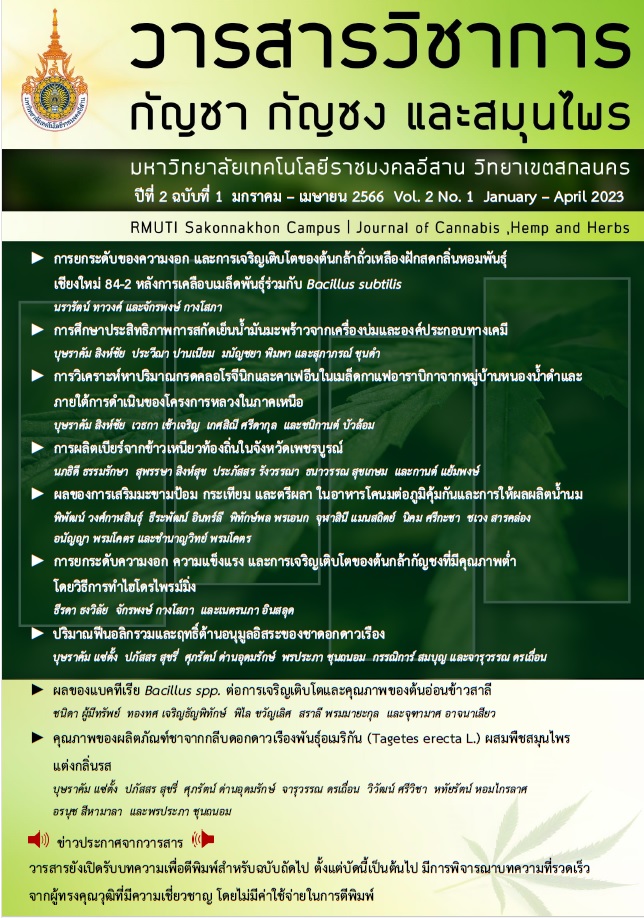การยกระดับความงอก ความแข็งแรง และการเจริญเติบโตของต้นกล้ากัญชงที่มีคุณภาพต่ำ โดยวิธีการทำไฮโดรไพรม์มิ่ง
คำสำคัญ:
กัญชง ไฮโดรไพรม์มิ่ง การดูดน้ำของเมล็ด การงอกบทคัดย่อ
การทำไฮโดรไพรม์มิ่ง (hydro-priming) เป็นวิธีการหนึ่งที่ช่วยส่งเสริมการงอกของเมล็ดกัญชง ระยะเวลาที่เหมาะสมสำหรับการแช่เมล็ดมีความจำเพาะเจาะจงและแตกต่างกันไปในพืชแต่ละชนิด เวลาในการแช่เมล็ดจึงเป็นสิ่งสำคัญของการทำไพรม์มิ่งเพื่อศึกษาระยะเวลาที่เหมาะสมสำหรับการทำไฮโดรไพรม์มิ่งของเมล็ดกัญชงต่อความงอก ความแข็งแรง และการเจริญเติบโตของต้นกล้ากัญชงพันธุ์ RPF 4 โดยนำเมล็ดพันธุ์กัญชงไพรม์ในระยะเวลาที่แตกต่างกันทั้งหมด 4 กรรมวิธี ดังนี้ เมล็ดที่ไม่ผ่านการไพรม์ T1) เมล็ดที่ผ่านการไพรม์ที่ 3, 6, และ 9 ชั่วโมง T2), T3) และ T4) ตามลำดับ พบว่าเมล็ดกัญชงที่ผ่านการทำไฮโดรไพรม์มิ่ง ส่งผลให้มีการเปลี่ยนแปลงด้านคุณภาพของเมล็ดในทุกลักษณะ รวมถึงความสูงของต้นกล้า และเวลาเฉลี่ยในการงอกน้อยกว่าเมล็ดที่ไม่ผ่านการไพรม์ โดยเฉพาะเมล็ดที่ผ่านการทำไฮโดรไพรม์มิ่งที่ 3 ชั่วโมง มีความงอกรากแรก ความเร็วในการงอกรากแรก ความงอก ความเร็วในการงอก ความสูงของต้นกล้าสูงที่สุดจากทุกกรรมวิธี การดูดซับความชื้นของเมล็ดกัญชงเข้าสู่ระยะที่ 2 ของการดูดน้ำที่ 7 ชั่วโมงและสิ้นสุดลงที่ 18 ชั่วโมงหลังดูดซับความชื้น ดังนั้นการทำไฮโดรไพรม์มิ่งที่ 3 ชั่วโมง และอุณหภูมิที่ 25 องศาเซลเซียส เป็นเวลาและอุณหภูมิแนะนำสำหรับการยกระดับคุณภาพเมล็ดพันธุ์ของเมล็ดกัญชงพันธุ์ RPF 4 ที่มีคุณภาพต่ำได้
เอกสารอ้างอิง
จักรพงษ์ กางโสภา เพชรรัตน์ จี้เพชร และ จุฑามาศ อาจนาเสียว (2564) อิทธิพลของการไพรม์เมล็ดร่วมกับ KNO3, KH2PO4 และ GA3 ต่อความงอกและการเจริญเติบโตของต้นกล้าผักบุ้งจีน. วารสาร มทร. อีสาน ฉบับวิทยาศาสตร์และเทคโนโลยี. Vol. 14, No. 2.
บุญมี ศิริ. (2558). การปรับปรุงสภาพและยกระดับคุณภาพเมล็ดพันธุ์. ขอนแก่น: มหาวิทยาลัยขอนแก่น คณะเกษตรศาสตร์ ภาควิชาพืชศาสตร์และทรัพยากรการเกษตร.
สถาบันพัฒนาอุตสาหกรรมสิ่งทอ. (2565). อุตสาหกรรมเส้นใยกัญชง. ค้นเมื่อ 10 ตุลาคม 2565, จาก http://thailandhemp.info/thti/hemp-shell-fiber.php?menu=281
สถาบันวิจัยและพัฒนาพื้นที่สูง (องค์การมหาชน) (2562). พันธุ์กัญชงกับเมล็ดพันธุ์รับรองตามกฎหมาย. ค้นเมื่อวันที่10 ตุลาคม พ.ศ. 2565
จาก https://www.hrdi.or.th/articles/Detail/47.
Asna, A. C., Joseph, J., and Joseph John, K. (2020). Botanical Description of Bitter Gourd. In The Bitter Gourd Genome. Cham: Springer,. pp. 7-31.
Baki, A.A., and Anderson, J.D. (1973). Vigor determination in soybean seed by multiple criteria Journal of Agronomy and Crop Science, 13(6), 630-633.
Bewley, J.D., Bradford, K.J. Hilhorst, H.W.M. and Nonogaki, H. (2013). Seeds: Physiology of Development, Germination and Dormancy, 3rd Edition. New York: Springer.
Dutta, P. (2018). Seed Priming: New Vistas and Contemporary Perspectives. Advances in Seed Priming, 3–22.
Callaway, J.C (2004). Hempseed as a nutritional resource: an overview. Euphytica, 140, 65–72
Dalil B. (2014). Response of Medicinal plants to Seed priming: A Review. International Journal of Plant, Animal and Environmental Sciences, 4(2), 741-745.
Dell Aquilla, A. and Beweley J.D. (1989). Protein synthesis in the axes of polyethylene glycol treated pea seed and during subsequent germination. Journal of Experimental Botany. 40, 1001-1007.
Golizadeh, S. K., Mahmoodi, T. M., and Khaliliaqdam, N. (2015). Effect of Priming of (KNO3, ZnSO4, Distilled water) on rate Germination and Seedling Establishment on Cannabis seed (Cannabis sativa L.). In Biological Forum 7(1), 190.
Harris, D., Tripathi, R. S., and Joshi, A. (2002). On-farm seed priming to improve crop establishment and yield in dry direct-seeded rice. Direct seeding: Research Strategies and Opportunities, International Research Institute, Manila, Philippines, 231-240.
Hussain, S., Khan, F., Hussain, H. A., and Nie, L. (2016). Physiological and biochemical mechanisms of seed priming-induced chilling tolerance in rice cultivars. Frontiers in plant science, 7, 116.
ISTA. (2004). International Rules for Seed Testing. Seed Science and Technology. Glattbrugg: Switzerland.
ISTA. (2018). International rules for seed testing, Edition 2018. International Seed Testing Association, Bassersdorf.
Kamithi, K. D., Wachira, F., and Kibe, A. M. (2016). Effects of different priming methods and priming durations on enzyme activities in germinating chickpea (Cicer arietinum L.). American Journal of Natural and Applied Sciences, 1(1), 1-9.
Muhammad, I., Kolla, M., Volker, R., and Günter, N. (2015). Impact of nutrient seed priming on germination, seedling development, nutritional status and grain yield of maize. Journal of plant nutrition, 38(12), 1803-1821.
Önol, B. and M.U. Yildirim. (2021). Breaking seed dormancy and regeneration in Cannabis sativa L. International Journal of Agriculture, Environment and Food Sciences, 5(4),709-719
Pawar, V. A., and Laware, S. L. (2018). Seed priming a critical review. Int. J. Sci. Res. Biol. Sci, 5, 94-101.
Selvarani, K., & Umarani, R. (2011). Evaluation of seed priming methods to improve seed vigour of onion (Allium cepa cv. aggregatum) and carrot (Daucus carota). Journal of Agricultural Technology, 7(3), 857-867.
Taylor, A. G., Allen, P. S., Bennett, M. A., Bradford, K. J., Burris, J. S., & Misra, M. K. (1998). Seed enhancements. Seed Science Research, Vol. 8(02)., 245 – 256.
Varier, A., Vari, A. K., and Dadlani, M. (2010). The subcellular basis of seed priming. Current Science,450-45
ดาวน์โหลด
เผยแพร่แล้ว
รูปแบบการอ้างอิง
ฉบับ
ประเภทบทความ
สัญญาอนุญาต
ลิขสิทธิ์ (c) 2023 วารสารวิชาการ กัญชา กัญชง และสมุนไพร

อนุญาตภายใต้เงื่อนไข Creative Commons Attribution-NonCommercial-NoDerivatives 4.0 International License.
ประกาศเกี่ยวกับลิขสิทธิ์
เนื้อหาและข้อมูลในบทความที่ลงตีพิมพ์ในวารสารทดสอบระบบ ThaiJo2 ถือเป็นข้อคิดเห็นและความรับผิดชอบของผู้เขียนบทความโดยตรงซึ่งกองบรรณาธิการวารสาร ไม่จำเป็นต้องเห็นด้วย หรือร่วมรับผิดชอบใด ๆ
บทความ ข้อมูล เนื่อหา รูปภาพ ฯลฯ ที่ได้รับการดีพิมพ์ในวารสารทดสอบระบบ ThaiJo2 ถือเป็นลิขสิทธิ์ของวารสารทดสอบระบบ ThaiJo2 หากบุคคลหรือหน่วยงานใดต้องการนำทั้งหมดหรือส่วนหนึ่งส่วนใดไปเผยแพร่หรือเพื่อกระทำการใดๆ จะต้องได้รับอนุญาตเป็นลายลักอักษรณ์จากวารสารทดสอบระบบ ThaiJo2 ก่อนเท่านั้น









